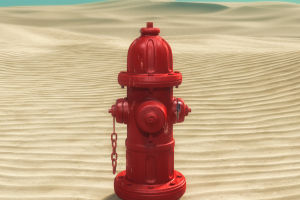
We pass by fire hydrants almost every day, but have we ever wondered why they come in different colors? These brightly painted hydrants aren’t just random—they actually carry important meanings, especially in emergency situations.
Today, let’s explore how fire hydrants work, why they’re painted in various colors, and what they mean in different parts of the world.
What Exactly Is a Fire Hydrant?
A fire hydrant is a water source that firefighters use to quickly access water during emergencies. These hydrants are connected directly to underground water pipes and allow for fast attachment of hoses. Their main job is to provide enough water pressure and volume to fight fires effectively. They’re built strong, designed to last, and easy to spot when every second matters.
The Design and Placement of Fire Hydrants
Fire hydrants are usually placed along sidewalks or at street corners. Their design can vary slightly from country to country, but the function is always the same. They’re typically made of metal and feature an outlet cap, a main valve, and a nozzle or two. To make them stand out, they’re painted in eye-catching colors like red, yellow, or blue—each with its own specific meaning.
Color Coding Around the World
In many countries, color is not just for show—it tells firefighters about the water pressure and flow capacity. For example:
- In the United States, a red hydrant usually means a lower water flow (less than 500 gallons per minute), while blue signals high capacity (over 1,500 GPM). Orange and green fall somewhere in between.
- In Hong Kong, China, hydrants are often red if they use fresh water and yellow if they draw from seawater.
- Other countries may use entirely different systems, but the goal is the same: to help emergency crews quickly understand what they’re working with.
Why Fire Hydrants Need to Be Highly Visible
Visibility is key. When a fire breaks out, every second matters. That’s why hydrants are often painted in bold colors. Red and yellow are especially popular because they’re easy to see—even at night or during bad weather. Some areas even install small reflective signs above hydrants for easier identification from a distance.
Maintenance and Safety
We might not think about it much, but hydrants need regular maintenance. Local departments usually check them every year to make sure they’re working correctly, the caps are tight, and no leaks are present. It’s also crucial for us not to park in front of hydrants or block them with trash bins—access needs to be instant during emergencies.
Fire Hydrants and Urban Planning
Fire hydrants are part of city infrastructure, and their placement is carefully planned. Urban engineers consider building density, traffic flow, and potential fire risks. In newer areas, hydrants are often spaced out every 300 to 500 feet to ensure quick access. In older neighborhoods, updates might be needed to meet modern safety standards.
Interesting Facts to Share
- In some cities, hydrants have GPS tags for faster detection by fire crews.
- In snowy regions, they’re sometimes fitted with tall poles so they can be found under snow.
- Some hydrants are designed with special locks to prevent tampering or theft of water.
Final Thoughts — Let’s Stay Aware, Lykkers!
Next time we see a fire hydrant, let’s take a second look. That bright color, that placement—it’s all part of a life-saving system. Understanding how hydrants work and why they look the way they do gives us a new appreciation for something we often ignore. And who knows? Maybe one day, this knowledge could help us stay safe or even save a life.
Stay curious and observant, Lykkers—have you noticed any colorful hydrants in your city? What color are they, and do you know what it means? Let’s talk in the comments!
Is there meaning behind the color of a fire hydrant?
Video by HydroMohsen


